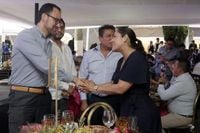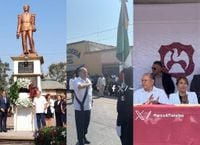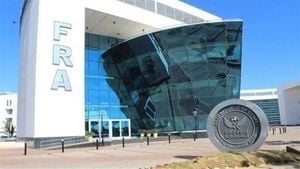On May 5, 2025, the National Chamber of the Restaurant Industry (Canirac) hosted its "Sabores del 5 de Mayo" food event, dedicated to the iconic Mole Poblano, in the atrium of the parish of San Andrés Apóstol. The event was a vibrant celebration that brought together restaurateurs, hoteliers, and service providers, all honoring the rich culinary tradition of this beloved dish.
Juan José Sánchez Martínez, president of Canirac, emphasized the significance of the event, stating it was a tribute to the creators of Mole Poblano. He highlighted that Mole is not just food; it represents resistance and identity, a homage to those who taught that the sacred can also be served at the table. This sentiment resonated deeply, especially as the event unfolded in the atrium of a church, creating a juxtaposition of the sacred and the culinary.
The culinary showcase featured creations from 20 participating chefs, each presenting their unique interpretations of Mole Poblano, utilizing distinct ingredients and techniques. The atmosphere was lively, with attendees savoring the diverse flavors and celebrating the cultural heritage that Mole embodies.
Simultaneously, the significance of May 5 extends beyond culinary festivities; it marks a day of political alliances and civic pride. In Puebla, a political alliance was solidified between Claudia Sheinbaum and Alejandro Armenta, who appeared together during a parade that celebrated both the Battle of Puebla and their collaboration. The parade was more than just a civic event; it was a display of power and mutual trust, suggesting a strategic partnership aimed at advancing the interests of Puebla.
The scene was dynamic, with flags waving and the sun shining down on the duo, who were not merely participating in a parade but were actively marking their political territory. This event was framed as a showcase for the '4T' movement, indicating that Puebla is becoming a focal point for this political agenda.
In addition to the political spectacle, the State Information and Communication System (SICOM) announced ambitious plans to enhance its presence in Puebla. With Alejandro Armenta’s administration, SICOM plans to establish 15 new offices and stations, adding to the existing eight. This expansion is seen as a strategic move to create a more representative media landscape that reflects the diverse realities of local communities.
SICOM's initiative aims to break away from the centralist narrative that often dominates media discussions, giving voice to the unique challenges and potentials of each region in Puebla. The director, Natalie Hoyos, is already working on this project, which promises to capture the stories of the people and strengthen the local identity.
The celebrations continued in Tepeaca, where the municipality commemorated the 163rd anniversary of the Battle of May 5, 1862, alongside the birth of General Miguel Negrete Novoa. Led by Mayor Julián Alfredo Velazquez Romero, the event saw active participation from over 10,000 students and teachers across 22 contingents.
The parade, which took place in the historic center of Tepeaca, included various groups such as students, parents, teachers, and local farmers. It was a vibrant display of community spirit, with participants from diverse educational institutions and local organizations. The mayor, along with honored guests, laid a floral offering at the house of General Miguel Negrete and at his monument, paying tribute to the local hero.
However, not all attention during the celebrations was positive. Deputy José Antonio López Ruiz faced backlash for wearing luxury glasses, allegedly Dior, valued at 20,000 pesos, during the May 5 parade. Critics pointed out that this flaunting of wealth contradicted the principles of austerity promoted by his party, the PT, and their ally, Morena.
López Ruiz defended himself on social media, stating that his possessions are the fruits of his labor and that he was born before the principles of the "fourth transformation" were established. His comments came just weeks after he reported being a victim of an assault outside a local church, which highlighted the ongoing issues of security and public safety in the region.
The juxtaposition of these events paints a complex picture of May 5 in Puebla. On one hand, the day serves as a celebration of cultural heritage, community spirit, and political alliances. On the other, it reveals the challenges and contradictions faced by public figures in navigating the expectations of their constituents.
As Puebla continues to evolve, both culturally and politically, the events of May 5 serve as a reminder of the rich tapestry of history and identity that defines this region. The culinary traditions, civic celebrations, and political maneuvers all intertwine, creating a narrative that is uniquely Puebla.
In the coming months, as SICOM expands its reach and political dynamics shift, the stories emerging from this vibrant state will undoubtedly reflect its diverse voices and complex realities. The challenge remains for leaders and citizens alike to engage with these narratives authentically, ensuring that every voice is heard and represented in the ongoing story of Puebla.





